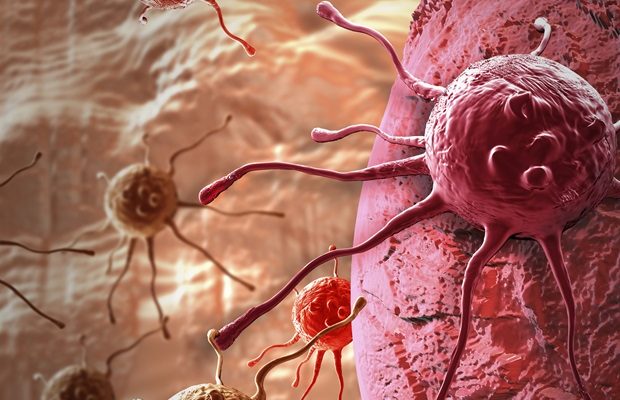Liver cancer's rapid growth leads to a vulnerability in its energy-production and cell-building processes that may be potently exploited with a new combination-treatment strategy, according to a study from researchers at the Perelman School of Medicine at the University of Pennsylvania.
In the study, published August 2 in Cell Metabolism, the researchers discovered that the main type of primary liver cancer, hepatocellular carcinoma (HCC), modifies its metabolism in a way that leaves it susceptible to disruptions in the supply of a key molecule, arginine. This arginine vulnerability, they found, is present in all HCC cancers regardless of the specific genetic mutations that gave rise to them.
The researchers showed in preclinical tests that starving HCC tumors of arginine, and also blocking the survival-promoting response that results, leaves HCC tumors in a no-growth, "senescent" state-;in which they can be killed off with a new class of drugs that target senescent cells.
"Essentially we identified a metabolic property of most liver cancers that offers the possibility of treating these cancers effectively, using drugs that are already approved or in development." said study senior author Celeste Simon PhD, the Arthur H. Rubenstein, MBBCh Professor in the Department of Cell and Developmental Biology, and scientific director of the Abramson Family Cancer Research Institute at Penn Medicine.
HCC is the most common form of liver cancer in adults. According to the National Cancer Institute, it accounts for roughly 80 percent of primary liver tumors – tumors that originate in the liver instead of spreading there from other organs. HCC occurs in about 29,000 Americans annually, nearly a million are detected worldwide, and it is thought to be caused by chronic liver inflammation due to hepatitis viruses, alcoholism, and obesity. The disease is seldom cured, because it tends to be diagnosed only after it has advanced beyond the possibility of surgical removal. Furthermore, liver transplants, which can cure benign disease, are often unavailable to advanced HCC patients. Drug treatments for HCC are limited and almost never result in cures. Thus, there is an urgent need for new treatment strategies.
The approach taken by Simon and her team-;targeting tumor metabolism-;is one that cancer researchers have been exploring more and more in recent years. Cancer cells usually find ways to modify their energy-production and molecule-building processes to accommodate their rapid growth. These modifications create vulnerabilities for the cancer cells that may be found in all or virtually all cases of a given cancer type. The challenge has been to identify these susceptibilities in different cancers and develop viable strategies for targeting them in a way that avoids metabolic redundancies and plasticity.
In the new study, Simon's team first established from existing cancer cell gene activity databases, and from tests on patient tumor samples and cancer cell lines, that virtually all HCCs turn up their metabolism by suppressing a biochemical process called the urea cycle. The urea cycle normally produces, among other things, an amino acid called arginine, which is a building-block of proteins and has many other important functions. The researchers showed that HCC cells compensate for their loss of internal, urea-cycle arginine production by importing arginine from their surroundings, mainly via a transporter protein called SLC7A1.
The researchers tried blocking SLC7A1 activity in HCC cells to starve them of arginine. This didn't kill the HCC cells, though. Instead, arginine starvation triggered a stress response that threw the cells into a dormant, slow-growth mode-;from which they could recover if arginine became available again. The researchers then tried blocking the stress response as well, and found that the HCC cells now were forced into a more profound and harder-to-reverse no-growth state called senescence.
The senescent state is one that many cells fall into during normal aging. So-called senolytic drugs to kill these cells are being developed by pharma companies, because removing senescent cells has been found to have a rejuvenating effect in animal models of aging. Simon's team used one of these experimental senolytic compounds, ABT-263, and found that it killed senescent HCC cells and caused very strong tumor regression in animal models of HCC.
The findings thus point to the possibility of a three-part combination treatment-;to starve HCC tumors of arginine, to block the ensuing stress response and induce senescence, and, lastly, to kill the resulting senescent HCC cells and stop tumor growth. Simon said it is possible that all three of these effects could be achieved with drugs that are already in use or being studied for other applications.
Conceivably this type of combination treatment, if implemented properly, would also make many patients more responsive to other treatments such as immunotherapies."
Celeste Simon, Study Senior Author and Arthur H. Rubenstein Professor, Department of Cell and Developmental Biology, University of Pennsylvania School of Medicine
The research was funded by the National Cancer Institute (T32 CA09140, P01 CA104838, R35 CA197602) and by the Belgian American Educational Foundation.
University of Pennsylvania School of Medicine
Missiaen, R., et al. (2022) GCN2 inhibition sensitizes arginine-deprived hepatocellular carcinoma cells to senolytic treatment. Cell Metabolism. doi.org/10.1016/j.cmet.2022.06.010.
Posted in: Medical Research News | Medical Condition News
Tags: Aging, Amino Acid, Arginine, Cancer, Carcinoma, Cell, Cell Metabolism, Chronic, Developmental Biology, Drugs, Education, Gene, Genetic, Genomics, Health Systems, Hepatitis, Hepatocellular Carcinoma, Hospital, Inflammation, Liver, Liver Cancer, Medical School, Medicine, Metabolism, Molecule, Obesity, pH, Preclinical, Protein, Research, Stress, Tumor, Urea Cycle
Source: Read Full Article
